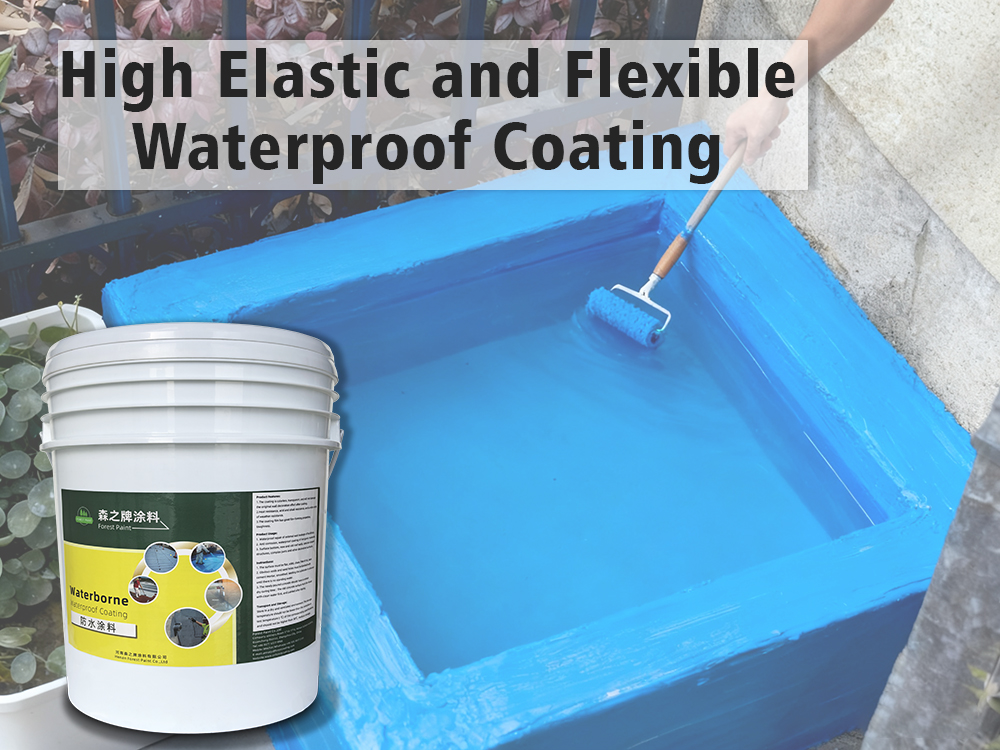In the world of construction and renovation, the waterproof layer is crucial. Driving rain, freezing temperatures, and the subtle, yet powerful, movement of structures over time. Traditional rigid waterproofing methods often fail when faced with these challenges, cracking under pressure and leaving properties exposed to water damage, mold, and structural decay.
1.What is a High-Elasticity Flexible Waterproof Coating?
At its core, a high-elasticity flexible waterproof coating is a liquid-applied membrane that cures to form a seamless, rubber-like blanket over surfaces. Unlike traditional cementitious or bitumen-based coatings, which are hard and brittle, this product is engineered with advanced polymers (such as acrylic, polyurethane, or polymer-modified cement) that give it exceptional stretchability and recovery.
Key Characteristics:
High Elasticity (Elongation): This is the feature. These coatings can typically achieve an elongation at break of over 300% to 600%,far exceeding the minimal movement capability of rigid coatings.
Seamless Application: Applied as a liquid, it forms a continuous membrane with no joints, seams, or overlaps.
Excellent Adhesion: It bonds tenaciously to a variety of substrates, including concrete, masonry, wood, metal, and even certain plastics.
Breathability: Many high-quality formulations are micro-porous, allowing trapped moisture vapor within the structure to escape (preventing blistering and peeling) while still blocking liquid water from entering.
Flexibility at Low Temperatures: A crucial advantage, it remains flexible and effective even in freezing conditions, whereas rigid coatings become more brittle and prone to cracking.
| Comparison dimension | Core component | Post-curing properties | Main advantages | Applicable scenarios |
| High-Elasticity Flexible Waterproof Coatings | Organic polymer materials (such as polyurethane, acrylic acid, polymer emulsions) | Flexible and elastic, with a high tensile rate, it can adapt to the deformation of the base layer | 1. Strong crack resistance2. Good weather resistance, suitable for high and low temperature environments3. Low to grass-roots flatness requirement, adaptation special-shaped structure4. Strong adhesion, can be constructed on complex surfaces | 1.Shape-changing area: bathroom wall, balcony, roof joint2.Irregular parts: pipe root, yin-yang Angle, tunnel3.Vibration scene: bridge, factory floor |
| Rigid waterproof coating | Inorganic materials (cement, quartz sand, sand and gravel) + waterproofing agents, additives | High hardness, brittleness, no elasticity, high compressive strength | 1. Excellent durability, anti-aging and anti-penetration2. Compression wear-resisting, able to bear external larger forces and hydrostatic pressure3. Low cost | 1. Stabilize the grassroots2. Water storage structure: pool, swimming pool, reservoir3. Load-bearing parts: roof leveling layer, underground garage floor |
2.Key Benefits and Advantages
(1)Unmatched Crack-Bridging Ability
All buildings move. Thermal expansion and contraction, settling, and vibrations from traffic can cause static cracks to widen and new hairline cracks to form. A rigid coating will simply crack along with the substrate, rendering it useless. A flexible coating, however, stretches over the crack, maintaining a continuous protective barrier.
(2)Superior Durability and Longevity
The combination of elasticity, strong adhesion, and UV resistance results in a membrane that withstands the test of time and harsh weather. It resists degradation from sunlight, rain, and temperature cycles, ensuring a long service life and reducing the frequency and cost of reapplications.
(3)Versatility Across Applications
Its unique properties make it suitable for a wide range of applications that are challenging for other products:
*Roofs & Terraces: Perfect for complex details around pipes. It can handle foot traffic and the constant thermal movement of roof surfaces.
*Wet Areas: An ideal solution for bathrooms, balconies, and kitchens, where it can be applied directly under tiles, protecting the substrate from leaking water.
*Below-Grade Structures: Provides robust protection for foundations, basements, and retaining walls, resisting hydrostatic pressure and ground movement.
*Swimming Pools and Water Tanks: Its seamless nature and constant immersion capability make it a top choice for containing water.
(4)Ease of Application
The application process is straightforward. It can be applied by roller, brush, or spray, conforming perfectly to complex shapes and details without the need for specialized cutting or welding equipment. This reduces labor time and the potential for human error during installation.
(5)Environmentally Friendly and Safe
Water-based means they have low VOCs (Volatile Organic Compounds). This makes them safer for applicators and occupants and less harmful to the environment compared to solvent-based alternatives.
When considering your next construction or renovation project,it safeguards the structural integrity of your building, protects the health of its occupants by preventing mold, and ultimately, preserves the value of your asset for decades to come.
Post time: Oct-29-2025


